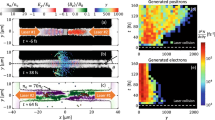Abstract
Starting from the non-linear relativistic equations of motion for charged particles in the very high intensity fields of laser radiation, the maximum kinetic energy ɛkin of the resulting oscillation is derived exactly. In non-relativistic conditions ɛkin agrees with the well-known valuee 2 E v 2/(2m0ω2|n|), showing a dependence on the rest massm 0 of the particle. In the relativistic case, the mass dependence vanishes. The multipole radiation is calculated on the basis of Sommerfeld's formula for relativistic conditions. It is shown that this radiation is not important for oscillation energies up to\( \in _{kin^{mr} } \)=70m 0 c 2 for electrons in neodymium glass laser radiation and up to higher values for CO2 lasers and for protons. With the limitationm 0 c 2 < εkin <\( \in _{kin^{mr} } \), the formula for ɛkin is used to calculate the pair production (a) for singly oscillating particles in vacuum without collisions and (b) for plasmas with collisions. Taking into account the local increase of the effective electric laser field near the cut-off density due to the decrease of ¦n¦ (n is the complex refractive index), there is the possibility of efficient proton pair production at intensities of 1019 W cm−2 for neodymium glass lasers and of 1017 W cm−2 for CO2 lasers, besides electron pair production.
Similar content being viewed by others
References
F. V. Bunkin andA. M. Prokhorov, Polarization Matiere et Rayounement, Volume Jubilaire en l'Bonneur d'Alfred Kastler, Paris (1969);N. G. Basov andN. Krokhin, Seminar at Lebedev Inst., 1969.
F. V. Bunkin andA. E. Kazakov,Sov. Phys. Doklady 15 (1971) 758–759.
T. W. Kibble,Phys. Rev. 138B (1965) 740–753.
W. Heisenberg,Z. Physik 90 (1934) 209–231.
A. Sommerfeld, ‘Vorlesungen Vol. III, Elektrodynamik,’ Wiesbaden (1948) 294.
H. Hora,Phys. Fluids 12 (1969) 182–191.
Th. Erber,Rev. Mod. Phys. 38 (1966) 626–659.
R. Kidder, Varenna Summer School (July 1969), UCRL-Preprint 71775 (1969).
L. Spitzer, Jr., ‘Physics of Fully Ionized Plasmas’, Interscience, New York (1956).
H. Hora, D. Pfirsch, andA. Schlüter,Z. Naturforsch 22a (1967) 278.
J. Lindl andP. Kaw,Phys. Fluids 14 (1971) 371–377.
L. C. Steinhauer andH. G. Ahlstrom,13 (1970) 1103–1105.
H. Hora,Opto-Electronics 2 (1970) 201–214.
H. Hora, ‘Laser Interaction and Related Plasma Phenomena’, eds.H. Schwartz andH. Hora, Plenum, New York, Vol. II (1972) 341.
P. Mulser andB. Green — see Fig. 5 of Reference 14.
B. Green andP. Mulser, ‘Laser Interaction and Related Plasma Phenomena,’ eds. H. Schwarz and H. Hora, Plenum, New York, Vol. II (1972) 381.
J. W. Shearer, R. E. Kidder, andJ. W. Zink,Bull. Am. Phys. Soc. 15 (1970) 1483.
J. W. Shearer, LLL (Livermore) Report UCRL-51254 (Aug. 1972).
F. F. Chen,Comments on Plasma Physics 1 (1972) 81.
R. Klima,Plasma Physics 12 (1970) 123.
J. Nuckolls, L. Wood, A. Thiessen, andG. Zimmermann, Paper presented at the VII International Quantum Electronics Conference, Montreal (May 1972).
K. Nishikawa,J. Phys. Soc. Japan 24 (1968) 916–922.
J. F. Freidberg andB. M. Marder,Phys. Rev. A4 (1971) 1549–1553;P. K. Kaw andJ. M. Dawson,Phys. Fluids 12 (1969) 2586–2591;W. L. Kruer andJ. M. Dawson, ‘Laser Interaction and Related Plasma Phenomena’, eds. H. Schwarz and H. Hora, Plenum, New York Vol. II (1972) 317.
The relativistic istabilities would cause complications if circulary polarized light were used: (C. Max andF. Perkins,Phys. Rev. Letters 29 (1972) 1731–1734).
For linear polarized light howeverP. Kaw andJ. Dawson,Phys. Fluids 13 (1970) 472 demonstrated an increase of the transparency of the plasma. Therefore the ‘effective collisions’ decrease, losses by absorption diminish, and the desired dielectric effects which decrease ¦n¦ and so increase the effective electric field strength became more pronounced.
Author information
Authors and Affiliations
Rights and permissions
About this article
Cite this article
Hora, H. Estimates for the efficient production of antihydrogen by lasers of very high intensities. Opto-electronics 5, 491–501 (1973). https://doi.org/10.1007/BF02109654
Received:
Issue Date:
DOI: https://doi.org/10.1007/BF02109654




